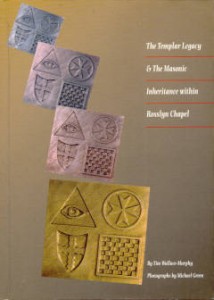The Templar Legacy & The Masonic Inheritance within Rosslyn Chapel.
By Tim Wallace-Murphy.
Published by “The Friends Of Rosslyn”. ISBN: 9521493-1-1.
There is no year of publication quoted. £7.95.
 This is an interesting little book (63 pages, paperback). Profusely illustrated it is an excellent ‘pictorial guide’ for those who have visited the Chapel and wish to have a souvenir of their visit as well as for those who would like some idea of the Chapel interior prior to a visit. The photographs, mainly by Michael Green, are excellent and are better than those achievable by the average visitor.
This is an interesting little book (63 pages, paperback). Profusely illustrated it is an excellent ‘pictorial guide’ for those who have visited the Chapel and wish to have a souvenir of their visit as well as for those who would like some idea of the Chapel interior prior to a visit. The photographs, mainly by Michael Green, are excellent and are better than those achievable by the average visitor.
A bibliography is included and quotes 42 other books etc. (none of them primary sources) The author adds 18 ‘notes’, which are indicated in the text. It is curious that these ‘notes’ quote books etc. not mentioned in the ‘suggested bibliography’. The author makes use of non-Scottish Masonic material. The idea that American or English Masonic practice is equivalent to Scottish Masonic practice is, of course, quite erroneous. This suggests that the author is not a Scottish Freemason yet his discussion of the origins of Scottish Freemasonry, his description of Scottish Masonic ‘symbolism’ and procedure might led some to believe that he is.
In the main this book is merely a repetition of previously published myths and legends which the author quotes freely and frequently. There is little in the way of original research. If myths and legends are repeated often enough, as many of these have been and continue to be, they gain the appearance of truth. The main myths that Knight Templars fled to Scotland, that Robert I was “Sovereign Grand Master of the Masonic Guilds” and, that the builder of Rosslyn Chapel was, “not only the patron of Craftmasonry throughout Scotland but a Grandmaster and an adept of the higher degree” etc., are repeated here. In respect of the latter the author states: “It is known that Earl William was appointed Grandmaster of various Orders, the Craftmasons and other hard and soft guilds in Scotland in 1441”. It is extremely frustrating not to be told where such ‘facts’ originate. Unfortunately lack of space means that these errors cannot be dealt with at this time. But there are a few points that can be mentioned which indicate the reviewer’s concerns.
The author refers to Guilds another, albeit minor, indication of the author’s apparent lack of knowledge regarding Scottish terminology and history. Another such example is the repetition of the ‘fact’ that Robert I and William St Clair were Grandmasters of such “Guilds”. As these bodies came into being a after the dates quoted it is difficult to accept such statements without evidence, evidence that is not supplied in this book, nor in any of the books quoted in the ‘suggested bibliography’.
A major error is the assertion that: “For instance every Prime Minister in England from Walpole in the eighteenth century to Ramsay MacDonald in the twentieth was a Grandmaster of the Freemasons”. So quotes the writer on page 31. It will come as a complete surprise to many Freemasons to learn that the following Prime Ministers were Grandmasters. Of which Grand Lodge the writer does not specify.
| 1 | Robert Walpole | (1676 – 1745) |
| 2 | Spenser Compton | (1673 – 1743) |
| 3 | Henry Pelham | (c.1695 – 1754 |
| 4 | Thomas Pelham-Holles | (1693 – 1768) |
| 5 | William Cavendish | (1720 – 1764) |
| 6 | James Waldegrave | (1715 – 1763) |
| 7 | John Stuart | (1713 – 1792) |
| 8 | George Grenville | (1712 – 1770) |
| 9 | Lord Charles Watson-Wentworth | (1730 – 1782) |
| 10 | William Pitt, Snr. | (1708 – 1778) |
| 11 | Augustus Henry FitzRoy | (1735 – 1811) |
| 12 | Frederick North | (1732 – 1792) |
| 13 | William Petty | (1737 – 1805) |
| 14 | William Henry Cavendish Bentick | (1738 – 1809) |
| 15 | William Pitt, Jan. | (1759 – 1806) |
| 16 | Henry Addington | (1757 – 1844) |
| 17 | William Wyndham Greenville | (1759 – 1834) |
| 18 | Spencer Perceval | (1762 – 1812) |
| 19 | Robert Banks Jenkinson | (1770 – 1828) |
| 20 | George Canning | (1770 – 1827) |
| 21 | Frederick John Robinson | (1782 – 1859) |
| 22 | Arthur Wellesley | (1769 – 1852) |
| 23 | Charles Grey | (1764 – 1845) |
| 24 | William Lamb | (1779 – 1848) |
| 25 | Robert Peel | (1788 – 1850) |
| 26 | John Russell | (1792 – 1878) |
| 27 |